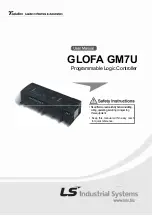
Service/maintenance
OPERATION MANUAL
Chapter 7
Unistat® T300 Series
V2.4.0en/22.07.20//17.12
92
7.4.3
Rinsing the thermal fluid circuit
Setpoint and overtemperature protection are not adjusted to the thermofluid
MORTAL DANGER FROM FIRE
The cut-out value of the overtemperature protection
must
be adapted to the thermofluid. Set the
cut-out value of the overtemperature protection 25 K below the fire point of the thermofluid.
The setpoint set during rinsing
must
be adjusted to the thermofluid used.
Non-compliance with the safety data sheet for the thermal fluid to be used
INJURIES
Risk of injury to the eyes, skin, respiratory tract.
The safety data sheet for the thermal fluid to be used must be read prior to using it and its
content must be respected.
Observe the local regulations/work instructions.
Wear your personal protective equipment (e.g. temperature-resistant safety gloves, safety
goggles, safety footwear).
Danger of slipping because floor and work area are contaminated. Clean the work station and
follow the instructions for the disposal of thermal fluid and material on page 17 in section
»Proper disposal of resources and consumables«
.
Mixing different thermofluids in a thermal fluid circuit
PROPERTY DAMAGE
Do
not
mix different types of thermofluid (such as mineral oil, silicone oil, synthetic oil, water,
etc.) in a thermofluid circuit.
The thermal fluid circuit
must
be rinsed when changing from one type of thermal fluid to an-
other. No residues of the previous type of thermal fluid may remain in the thermal fluid circuit.
The inner components of the temperature control unit must be dried out Need to avoid boiling
retardation during future uses (e.g. use of a silicone oil at temperatures above about 100
°C).
PROCEDURE
Drain the temperature control unit as described on page 70 in section
or on page 73 in section
»Draining externally open applications«
.
Residual thermal fluid can remain in the pump chamber and the internal lines after draining. Leave
the temperature control unit with open valves for a while.
Leave the drain hose mounted to the
>Drain<
[8].
Leave the drain hose attached to the
>Expansion vessel drain<
[9] (if present).
Check the filling level of the collecting containers at the other ends of the draining hoses. Follow
the instructions for the disposal of thermal fluid on page 17 in Section
.
Close the drain valves on the temperature control unit by turning them clockwise (turn 90° right
as far as they will go).
Re-fit the knurled screw to the
>Drain<
[10] (if present).
Connect the
>Circulation flow<
[1] with the
>Circulation return<
[2] to the temperature control
using a bypass hose.
Perform the following steps without attaching a short circuit hose, if the application used by you (exter-
nally closed) is also dirty. In this case, leave your externally closed application connected to the tempera-
ture control unit. This rinses the temperature control unit and your application at the same time.
Fill
the system (minimum fill level) with the thermal fluid you wish to use. The filling process is
described on page 67 section
»Filling and venting externally closed application«
.
Vent
the system as described on page 67 section
»Filling and venting externally closed application«
.
Example: Connecting a
short circuit hose
Содержание Pilot ONE Unistat T3*0
Страница 1: ...Unistat T300 Series...
Страница 2: ......
Страница 3: ...OPERATION MANUAL Unistat T300 Series...
Страница 4: ......
Страница 7: ...OPERATION MANUAL V2 4 0en 22 07 20 17 12 Unistat T300 Series 7 Layout of the Home screen...
Страница 99: ...Annex Chapter 9 OPERATION MANUAL V2 4 0en 22 07 20 17 12 Unistat T300 Series 99 9 Annex...









































